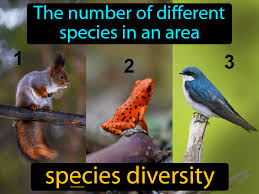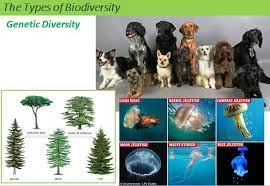Biodiversity definition:
The variety of animals, plants, fungi, and even microorganisms like bacteria that make up our natural environment are all included in what is known as biodiversity. These various species and critters collaborate in complicated web-like ecosystems to keep things in balance and support life.

Classification of Biodiversity:
1.Species diversity.
2.Ecological diversity.
3.Genetic diversity.

1.species diversity:
The number of distinct species present in an environment and the relative abundance of each species are the two components that make up species diversity. When every species present is equally plentiful in the area, diversity is at its highest.

Importance of species diversity:
The importance of species diversity can be argued for a variety of reasons. The environment depends on each species in some way. Bees are a perfect example of a primary pollinator. Consider the consequences if bees become extinct. Next may come fruits and vegetables, then the animals that consume them, and so on all the way to us. Many species not only give us food but also clean water, breathable air, fertile soils, a stable climate, the ability to absorb pollution, building materials for our homes, the ability to prevent disease outbreaks, the availability of therapeutic resources, and much more.
2.Ecological diversity:
The broadest definition of biodiversity is ecological diversity. Ecological diversity on a global scale would examine the variety in habitats like wetlands, deserts, grasslands, forests, and oceans. There is a substantial amount of species and genetic diversity within each ecosystem.

Importance of Ecological diversity:
Ecosystem diversity describes the variety of organisms in a specific environment and the biological processes that give them meaning. The variety of the species that make up an ecosystem is frequently measured, along with the relative abundance of various species and consideration of the type of species. The ecosystem is the conglomeration of populations of living creatures and the environment they inhabit. The variety of biological communities that interact with one another, with their physical and chemical environments, is referred to as ecosystem diversity.
3.Genetic diversity:
The biological variation that exists within species is known as genetic diversity. It enables species to adapt to changing environmental conditions. Under conditions of rapid environmental change, such as those found in the Baltic Sea, genetic diversity is particularly crucial.

Importance of Genetic diversity:
It is possible for organisms to adapt to changing environmental conditions and prevent inbreeding by maintaining significant genetic variety. When there are limited, isolated populations, inbreeding takes place, which might make a species less able to endure and procreate.
Biodiversity in India:
One of the twelve countries with the most biodiversity is India. India ranks fourth in Asia and tenth in the world for plant diversity, with over 47 000 plant species. Around 15 000 flowering plants, or 6% of all flowering plants worldwide, may be found in India.India is one of the world’s most diversified countries. In terms of the diversity of plant species, it comes in tenth. India is home to two of the top 25 biodiversity hotspots on earth. Important agricultural species like the pigeon pea, eggplant, cucumber, cotton, and sesame are descended from it. Many domesticated species, including millets, grains, legumes, vegetables, medicinal and aromatic crops, etc., are also widely grown in India.

You must be logged in to post a comment.